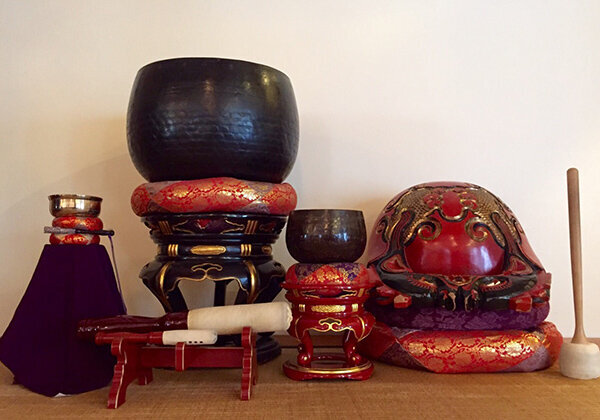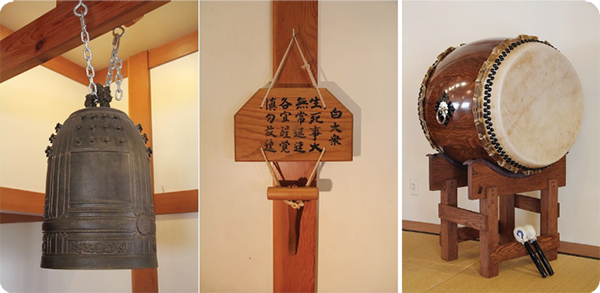Use of Cookies
Our website uses cookies to facilitate and improve your online experience.
A temple has various musical instruments which together are called narashimono. These instruments are most often played to lead the monastics and other attendees in service. They are also used to mark the passage of time or to signal changes and progress in temple activities.
The bell installed in the main hall is called the denshō. It is rung to announce the beginning of a ceremony or to assemble the participants. Using a wooden mallet, a monk rings the bell gently and slowly first, then gradually speeds up. Usually, there are three rounds of tolling. The end of the first round indicates that the main hall is ready for the service. Then, the end of the second round indicates that all the officiating monks have gathered in the hall. Finally, the end of the third round indicates that the officiant is ready to enter the main hall.

A mokugyo is a wooden percussion instrument in the shape of two fish facing each other. The mokugyo is used to keep the rhythm of sutra chanting and it is sounded with a cloth-covered stick called a bai. The original type of mokugyo is known as gyoku or hō and it is uniquely used in the Zen school.
The gyoku is hung from the ceiling of the sōdō (monks'hall) or dining hall, and a serving monk or nun strikes it to announce the beginning of each meal. The shape of the mokugyo is attributed to a belief people once had about fish – that, since their eyes are always open, they never sleep. Thus, monastics should practice assiduously without indulging themselves in sleep. The most common type of mokugyo has the scales of a fish carved on its surface. The fish generally has the body of a fish and the head of dragon bearing a ball in its mouth.
A keisu is a bell made of bronze in the shape of a bowl. Its bottom rests on a cushion called a shitone and the person sounding the bell rings it with a cloth-covered stick called a bai. Keisus can be classified into two types: daikei, large bowl bell, and shokei, small bowl bell. Each has a role in controlling the tone of the sound during sutra chanting. Keisus are used like tuning forks, and they also signal the beginning and the end of sutra chanting.
A shukei (sometimes called inkin) is a small portable bowl bell made from brass or other metal which is attached to a handle…… The person sounding the bell rings it with a metal or wooden striker. The shukei is used to lead the procession and the recession of the officiant or to signal the beginnings of prostrations. In the Soto Zen tradition of service, a pair of persons sounding the bell use two shukei tuned to different tones.
Moppans (sometimes called hans) are installed in many corners of temple complex including the hattō (dharma hall), sōdō (monks hall), and kuri (kitchen). A monastic strikes the moppan with a mallet when he or she arrives at the mountain gate for the first time to join the practice. Also, moppans are used to confirm whether monastics from all quarters of the temple complex are ready for a ceremony.
The taiko (drum) is used to mark the passage of time or the beginning of activity. During kitōhōyo, a type of ceremony in which monastics wish for the well being of people, a person playing the drum beats it instead of a mokugyo to keep the rhythm of sutra chanting.
Narashimono are extremely important in the Soto Zen tradition. Thus, to sound narashimono with utmost care is one of the most important practices for all Soto Zen priests. When you attend a Buddhist ceremony, please pay attention to the sounds of the instruments and remember that each sound has a special meaning.

Densho / Moppan / Taiko